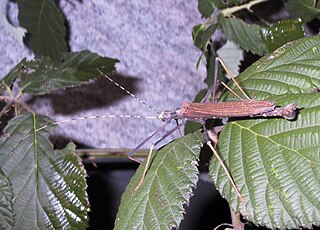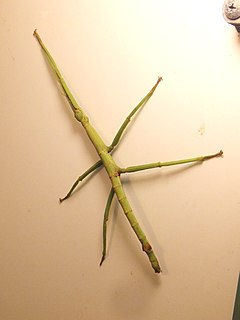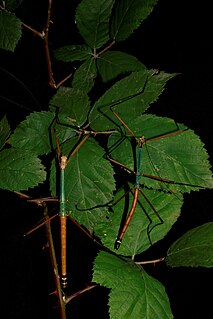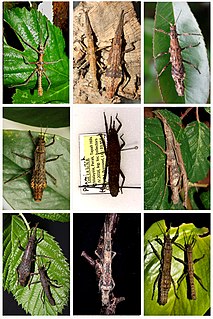
Phobaeticus is a genus of Asian stick insects comprising over 25 species.

Pseudophasmatidae is a family of stick insect, in the suborder Verophasmatodea, commonly called the "striped walkingsticks". An important identifying characteristic is its mesothorax, which is never more than three times as long as the prothorax.
Malacomorpha is a genus of striped walkingsticks in the family Pseudophasmatidae. There are about 15 described species in Malacomorpha.

Pharnacia is a tropical Asian genus of stick insects in the family Phasmatidae and subfamily Clitumninae.
Asceles is a genus from the stick insect family Diapheromeridae. Some of the species of Asceles have a distribution in Malaysia and Singapore.

Diapheromerini is a tribe of walkingsticks in the family Diapheromeridae. There are at least 30 genera Diapheromerini.

Necroscia is an Asian genus of stick insects in the family Diapheromeridae and subfamily Necrosciinae. Species have been recorded from South-East Asia.

Lopaphus is an Asian genus of stick insects in the family Diapheromeridae and subfamily Necrosciinae. Species have been recorded from India, China and South-East Asia.

Pylaemenes is a genus of stick insects in the family Heteropterygidae and subfamily Dataminae. It combines small to medium-sized, often brightly colored Phasmatodea species. Their representatives are found in large parts of Southeast Asia.
Tirachoidea is an Asian genus of stick insects in the family Phasmatidae and tribe Pharnaciini. Species have a known distribution from India, Indochina and West Malesia.
Isagoras is a genus of striped walkingsticks in the family Pseudophasmatidae. There are more than 25 described species in Isagoras.
Monticomorpha is a genus of striped walkingsticks in the family Pseudophasmatidae. There are 8 described species in Monticomorpha.

Anchiale is a genus of stick insects in the family Phasmatidae and tribe Phasmatini. Species have a known distribution from Australasia. The type species, A. maculata, was originally thought to be a Mantis.

Datamini is the only tribe within the subfamily of the Dataminae from the order of the Phasmatodea. The representatives of this subfamily are on average not as large as those of the other two subfamilies belonging to the family of Heteropterygidae.

Heteropterygini is the only tribe within the subfamily of the Heteropteryginae from the order of the Phasmatodea in the family Heteropterygidae. With 19 representatives described, this subfamily represents both the species-poorest and that of the three subfamilies, to which the largest and most striking species are counted.

The genus Dares, which is mainly native to Borneo, combines relatively small and mostly dark-colored Phasmatodea species.

Hoploclonia is the only genus of the tribe Hoplocloniini and brings together relatively small and darkly colored Phasmatodea species.

Haaniella is a genus of the Phasmatodea family Heteropterygidae from Southeast Asia.

The Cladomorphinae are a subfamily of stick insects in the family Phasmatidae. This taxon is particularly well represented in the Neotropical region, but records also exist for Madagascar, Java and the Maluku Islands.

Dares ulula is a species of stick insects. Like most other members of the genus Dares, the species is native to Borneo, more precisely in the northwest of the island. The males are extremely prickly even for the representatives of the genus Orestes. Females are colored with a relatively high contrast.















